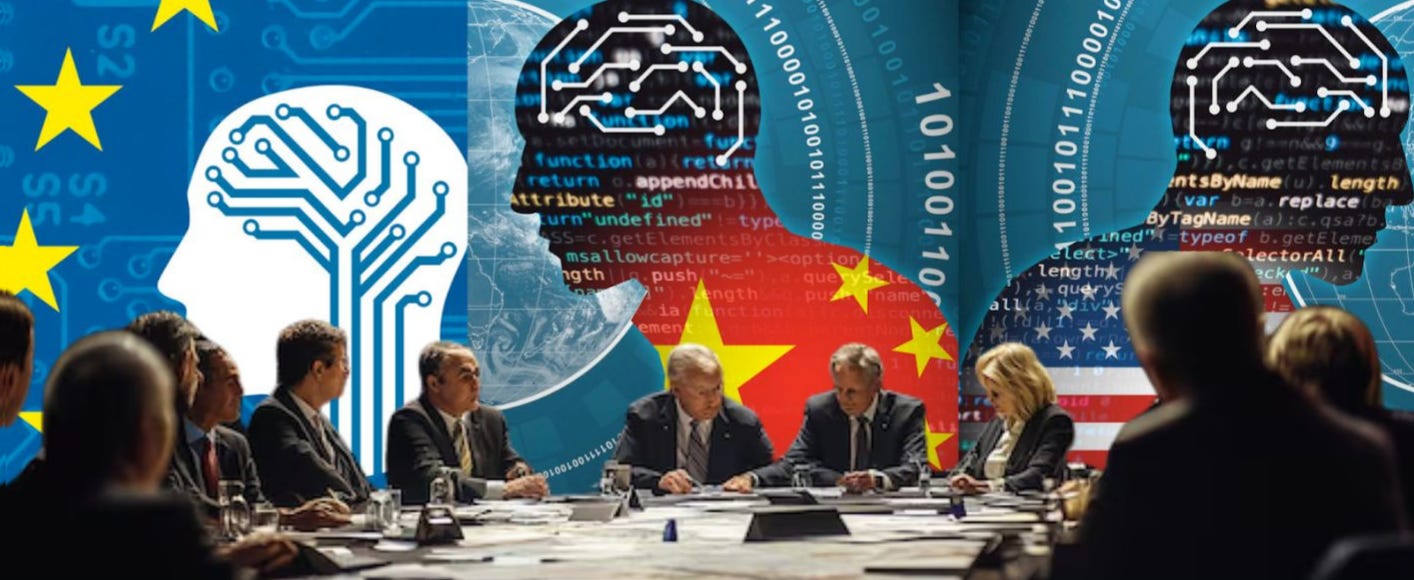The Inflection Point of AI
Think about your day. Did you ask Siri or Alexa a question? Did you scroll through a social media feed curated by AI algorithms? Chances are, you interacted with AI multiple times before breakfast. It's become so commonplace, we often don't even notice it. Yet, the recent headlines surrounding DeepSeek, a powerful AI model caught in the crossfire of US-China tensions, serve as a stark reminder that this technology is not just convenient; it's powerful, and its future is uncertain.
Just weeks ago, DeepSeek, a Chinese AI company specializing in large language models (“LLM”), achieved a remarkable feat: its app climbed to the number one spot on the Apple App Store on January 20. This achievement surprised many in Silicon Valley and the broader AI community, as DeepSeek's LLM demonstrated capabilities comparable to, or even exceeding, those of models developed by US giants like OpenAI, Google, and Meta. These US companies have invested heavily, spending billions to acquire cutting-edge chips and vast datasets for their complex problem-solving models. DeepSeek, in contrast, seems to have achieved similar performance levels at a significantly lower cost. Their researchers, in a late December publication, estimated the development and training of their V3 model at under $6 million, utilizing approximately 2,000 Nvidia H800 chips. This contrasts sharply with US companies like Meta, which are scrambling to secure billions of dollars worth of Nvidia's flagship H100 GPUs for their chatbot development. Due to US sanctions, China is unable to obtain H100s and instead relies on the less powerful H800s chips.
China’s Deepseek is now at the forefront of the AI revolution, directly challenging US-based OpenAI, Google DeepMind, and Anthropic. Deepseek’s breakthrough innovation is efficiency, it runs on mid–tier infrastructure, bypassing NVIDIA’s high-end GPUs. This open-source approach has made Deepseek a preferred alternative for startups and governments seeking independence from US tech.
DeepSeek's newfound prominence quickly attracted attention from US regulators and sparked concerns about data security, potential misuse, and the implications for US-China technological competition. These concerns had tangible effects, rippling through the US stock market as investors reacted to the uncertainty surrounding the future of AI development and the potential for regulatory interventions.
As a leading provider of GPUs, the specialized chips crucial for training and running AI models which companies like Google, Meta and OpenAI are rely heavily on, NVDA stock drops at the lowest 16% just in a week after DeepSeek become number one in AppStore. The market has reacted to this news by selling off Nvidia stock, fearing that DeepSeek's breakthrough could disrupt Nvidia's dominance in the AI chip market. The significant drop in Nvidia's stock price reflected this concern and the uncertainty about the future of AI hardware demand.
Behind the Scene: China’s AI Strategy
China's government has long recognized AI as a strategic national asset, viewing it as crucial for economic growth, technological leadership, and national security. This recognition is evident in the country's 14th Five-Year Plan (2021-2025), which explicitly prioritizes technological self-sufficiency. AI is a central focus of this plan, with specific emphasis on driving advancements in key sectors like healthcare, defense, and smart infrastructure (e.g., smart cities and traffic management). These ambitious goals are backed by substantial, long-term investments in both domestic semiconductor production (aiming to reduce reliance on foreign chips) and AI research and development. China is pouring billions of dollars into these areas, seeking to create a robust and self-reliant AI ecosystem.
DeepSeek's recent success, particularly its ability to seemingly achieve high performance at a lower cost, aligns perfectly with China's broader strategic initiative to challenge US tech hegemony. It demonstrates progress toward the goal of AI self-sufficiency and competitiveness. This drive is not limited to domestic development. The Belt and Road Initiative (BRI), a massive infrastructure project spanning Asia, Africa, and beyond, includes a significant "Digital Silk Road" component. This digital arm of the BRI actively promotes the export of Chinese digital technologies, including AI-powered solutions, to partner countries.
China leverages AI to strengthen its global influence by offering nations smart city technologies (e.g., facial recognition systems, data analytics platforms), surveillance systems (raising concerns about human rights and potential misuse), and data-driven economic solutions (e.g., AI-powered financial services, personalized recommendations).
While this strategy undoubtedly boosts China's diplomatic clout and expands its technological footprint, it has also fueled significant international concerns. The deployment of Chinese AI technology, particularly surveillance systems, in various regions has raised alarms about data privacy, potential misuse of personal information, and the erosion of civil liberties. Critics argue that these systems could be used for social control and political repression. Furthermore, the close relationship between Chinese tech companies and the government raises questions about data security and potential access to sensitive information by the Chinese state.
Beyond Technology: AI's Impact on Global Politics
AI is rapidly becoming a central player in global politics, shaping both international relations and domestic governance. Nations are leveraging AI to achieve strategic objectives across multiple domains.
Defense and Cybersecurity
AI-driven defense systems, including autonomous drones, advanced surveillance technologies, and sophisticated cybersecurity tools, are transforming the military landscape. Countries are heavily investing in AI to enhance their defense capabilities, contributing to a new kind of arms race—an AI arms race. For example, the US Department of Defense's Project Maven leverages AI to analyze vast amounts of battlefield data, improving targeting systems for drones and potentially increasing the speed and accuracy of military operations. This raises ethical concerns about the use of lethal autonomous weapons and the potential for unintended escalation.
Public Diplomacy and Information Influence
AI is being used to amplify specific narratives and influence public opinion at both domestic and international levels. China's AI-driven "Great Firewall" not only censors content internally but also shapes global narratives through platforms like TikTok and WeChat. These platforms have been accused of promoting pro-China content and suppressing dissenting voices, particularly on sensitive topics like Xinjiang and Hong Kong. In response, the US has implemented measures like Project Texas, aimed at isolating TikTok's US operations to prevent data access by Chinese authorities, highlighting the growing tension in the digital sphere.
Economic Competition and Trade
The AI race has significant economic implications. US export bans on advanced AI chips, intended to hinder China's technological progress, also disrupt global supply chains and create instability in the semiconductor industry. China, in response, is accelerating its efforts to develop indigenous AI hardware, aiming for self-sufficiency in this critical area. The intensifying competition over AI infrastructure, including cloud computing services and advanced semiconductor manufacturing, is expected to heavily influence future trade negotiations and the formation of technology alliances. This competition underscores the crucial role AI now plays in economic security and global competitiveness.
The AI Imperative: Balancing Innovation and Control
As AI becomes integral to national security, economic development, and even social control, governments worldwide are grappling with the complex challenge of regulating this transformative technology. The need for regulation is clear: to mitigate potential risks like bias, discrimination, job displacement, and misuse, while simultaneously fostering innovation and responsible development. However, finding this balance is proving to be a delicate act.
The European Union's proposed AI Act aims to establish global standards for transparency, safety, and ethical AI usage. It takes a risk-based approach, categorizing AI applications based on their potential harm and imposing corresponding levels of regulatory scrutiny. This effort to create a comprehensive framework is laudable, but its implementation faces challenges, including defining "AI" precisely and keeping regulations adaptable in the face of rapid technological advancements. Moreover, the EU's approach, with its emphasis on individual rights and data protection, contrasts sharply with the approach taken by other nations.
In China, AI governance is tightly intertwined with broader political objectives. Regulations prioritize state control over data and technology, with a strong emphasis on safeguarding "digital sovereignty" and maintaining social stability. This approach often prioritizes the collective good (as defined by the state) over individual privacy rights, and it can create barriers for foreign companies operating within China's digital space. This divergence in regulatory philosophies between democratic and authoritarian regimes risks fragmenting the global regulatory landscape, creating inconsistencies and challenges for businesses operating internationally.
These differing approaches to AI regulation are increasingly influencing diplomatic relations. Countries are being pressured to align with either US- or China-led standards, creating a new dimension of geopolitical competition. For multinational corporations like DeepSeek, navigating this patchwork of varying regulations is a significant challenge. Adapting operations to meet local rules, such as content moderation guidelines, data security requirements, and even definitions of "acceptable" AI applications, can be complex, costly, and even contradictory. This regulatory fragmentation can stifle innovation, increase compliance burdens, and potentially create a competitive disadvantage for companies that operate across multiple jurisdictions.
The global community faces a crucial task: finding common ground on core principles for AI governance to ensure that this powerful technology is used responsibly and ethically, while still allowing for continued innovation.
Future Outlook: The AI Revolution
The future of AI remains an open question, extending beyond a simple US-China rivalry. This global technological transformation will reshape economies, workforces, and societies worldwide. Will Silicon Valley's innovation or Beijing's planning prevail? A hybrid approach, or the rise of new AI leaders, is possible. The choices made globally regarding AI regulation, investment, and ethics will have ripple effects across all nations, influencing access to technology, economic competitiveness, and cultural landscapes. As AI advances, the stakes are high for everyone. The future of technology, and its impact on the global community, depends on the decisions made in the coming years. The inflection point is ongoing, and all must be prepared to adapt and thrive in this transformative wave.















